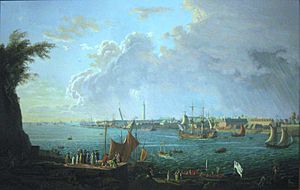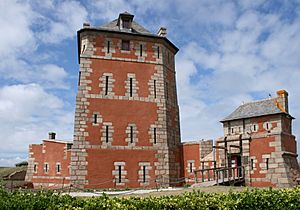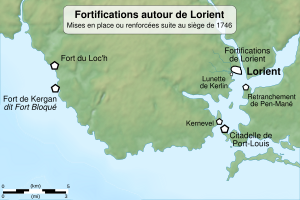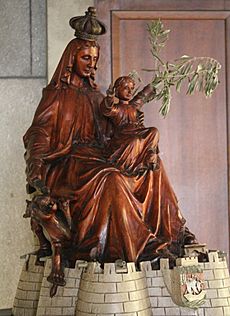Raid on Lorient facts for kids
Quick facts for kids Raid on Lorient |
|||||||
|---|---|---|---|---|---|---|---|
| Part of the War of the Austrian Succession | |||||||
 A painting of Lorient during the 18th century |
|||||||
|
|||||||
| Belligerents | |||||||
| Commanders and leaders | |||||||
| Strength | |||||||
| 4,000-6,000 soldiers | 16 ships of the line 8 frigates 2 galiots 43 troopships 4,500 soldiers |
||||||
The Raid on Lorient was a military attack by the British on the French town of Lorient in 1746. It happened during a big European conflict called the War of the Austrian Succession. The British wanted to make France move its soldiers away from a battlefront in Flanders (modern-day Belgium and Netherlands) to defend its own coast.
Lorient was also important because it was a main base for the French East India Company. This company traded goods from places like India. The British hoped to destroy this base to hurt France's trade.
About 4,500 British soldiers sailed to Lorient. But their ships had to wait for several days off the coast. This gave the people of Lorient time to get ready and call for help. The British troops finally reached the town's edge on October 3. They tried to get the town to surrender, but talks failed.
The British started bombing Lorient from October 5 to 7. But on October 7, the British commander ordered his troops to leave. Their engineers weren't very good, and many soldiers got sick or tired. The French commander had actually planned to give up because his defenses were weak. He offered to surrender right after the British left, but his message was never received.
This raid is remembered for two main reasons. First, it made France build stronger defenses in southern Brittany. Second, it led to a special religious tradition in Lorient. The town believed the Virgin Mary helped them win.
Understanding the Raid
What Caused the Attack?
The raid on Lorient was part of the larger War of the Austrian Succession. This war involved many European countries fighting over who would rule Austria. Britain and France were on opposite sides.
Why Britain Attacked France
In 1745, Britain had captured a French fort called Louisbourg in North America. After this win, the British government thought about attacking Quebec in Canada. This would give Britain control over Canada.
A large British force was prepared for this mission. It included soldiers led by Lieutenant General James St Clair and ships led by Admiral Richard Lestock. They were ready to sail by June 1746.
However, it was decided it was too late in the year to sail across the Atlantic. Also, a French fleet had just left to try and take back Louisbourg. So, the British decided to use their prepared force for a different mission: attacking France itself.
Choosing Lorient as a Target
General St Clair was told to attack Lorient, Rochefort, La Rochelle, or Bordeaux. He preferred Bordeaux at first because he knew the area and it wasn't fortified.
Admiral Anson, who was also in Plymouth, told St Clair that Lorient in southern Brittany was not well protected. So, they decided to send ships to scout that coast.
The final decision was to attack Lorient. This was because Lorient was the main base for the French East India Company. Attacking it would hurt France's trade. Also, it would make France move troops from Flanders to defend its own coast. This would help Britain in the war.
British Preparations for the Raid
Britain had changed its military tactics over the years. Instead of just bombing ports, they started planning bigger attacks where soldiers landed from ships. An example was the 1694 Battle of Camaret.
Vice Admiral Richard Lestock was chosen to lead the British fleet. He had 16 large warships, 8 smaller ships, and 43 transport ships. The historian and philosopher David Hume became secretary to General St Clair, who led the soldiers.
St Clair's force had about 4,500 men from different regiments. The commanders were not sure if Brittany was the best target. St Clair didn't even have a good map of the region. The British also couldn't get horses for their troops. The fleet left Plymouth on September 26.
How France Got Ready
French Intelligence
French spies knew that a lot of British troops were gathered in Plymouth. But they didn't know where the British planned to attack. An agent reported that the British force had little food and few horses. This suggested a small attack on the French coast.
French port commanders were warned, especially at Port-Louis on September 24. Coastguard militias were sent to the coast.
Lorient's Defenses
By the late 1600s, many parts of Brittany's coast had new forts. But the area around Lorient was still weak. The main fort, Citadelle de Port-Louis, was old. The city itself only had low walls on its land side and no other defenses along the coast.
Lorient had become a busy trading port. It had shipyards for the French navy and the East India Company. The company had moved its main base to Lorient in 1732. Nearby islands like Belle-Île, Houat, and Hoëdic were also important for ships.
The Raid Begins
British Landing and French Response
The British fleet arrived off Lorient on September 29. Lestock chose Pouldu bay for the landing, even though it was 16 miles from Lorient. He delayed the landing until October 1, giving the French more time to prepare.
The landing happened on Saturday, October 1. Bad weather delayed it further. This allowed French coastguards to confirm the fleet was British. British forces landed on three beaches, with groups of 400 to 1,000 men. Lestock's ships fired cannons to support them.
The first French defenders were coastguards. They were mostly farmers with simple weapons like staffs and pikes. There were also three cavalry companies. In total, about 2,000 men were led by Marquis De L'Hôpital.
News of the British landing reached Lorient on September 30. Many wealthy people left the city. Troops from nearby towns like Vannes and Rennes were sent to help. Peasants and coastguard militias fought small battles to slow down the British.
De L'Hôpital took command of Lorient's defenses on October 1. He wanted his troops to fight the British in the countryside. But the townspeople wanted him to defend the city directly.
Marching to Lorient
British Advance
The British land attack started on October 1, 1746. It was difficult because of rain, which made the ground muddy. It was also hard to bring supplies from the beaches to the troops.
On October 2, most British troops marched towards Lorient. General St Clair didn't have a good map. He also couldn't get information from local prisoners because they spoke Breton, not French.
The British divided their troops into two groups. One went to Plœmeur, and the other went north. The northern group was attacked by 300 French militiamen. Both groups eventually met near Plœmeur. They attacked and looted Plœmeur before moving towards Lorient. The British reached Lorient around 3 PM and set up camp.
French Reactions and Reinforcements
On the evening of October 3, the British sent a message to Lorient. They demanded the town surrender. St Clair wanted to allow his troops to loot the town for four hours and demanded a lot of money. The French refused. They wanted to retreat with honor and ensure the town and the East India Company's stores were not looted. St Clair refused these terms on October 4.
The British then tried to bring their ships' cannons to the town to start a siege. But they had no horses or pack animals. Soldiers had to carry everything on their backs, which made them very tired. Many soldiers got sick.
French militias made several small attacks on the British. Their main goal was to gain time for reinforcements to arrive. On October 5, King Louis XV of France in Versailles heard about the attack. He decided to send many troops from the Flanders front to help Lorient.
The Siege and British Retreat
British Struggles
British engineers had promised to destroy the town in 24 hours. But they failed. Their cannons didn't have enough cannonballs, and their mortars (another type of cannon) were missing parts. A third of the British troops had to carry the heavy artillery, which exhausted them.
The actual siege began on October 5, and the bombing started on October 6. However, the British cannons were too far away from the town. They caused little damage. Lorient's stone houses were strong against the cannon fire.
The British force got smaller due to tiredness and sickness. By October 6, only 3,000 men were still able to fight. They also had to defend their camp from French militia attacks.
Admiral Lestock warned that storms were coming and he couldn't keep his ships offshore much longer. General St Clair realized he had to stop the siege. On October 7, the British decided to retreat. They kept bombing the town to hide their departure. The last troops got back on their ships on October 9. The fleet finally sailed away on October 10.
French Defense and Victory
The people of Lorient quickly prepared their defenses. Cannons from ships were put on the town walls. New defenses were built. By October 6, almost 15,000 militiamen were in the town, but they were not well-trained.
On October 6, French cannons started firing back at the British. They used better cannonballs. On October 7, the French fired about 4,000 shots. They also captured three British deserters. These deserters revealed that the British force was only 3,000 men, not the 20,000 that the French had feared.
On the evening of October 7, a British cannonball landed near the French command center. The French commanders, De Volvire and de L'Hôpital, thought the British were about to get stronger. They decided to surrender. De L'Hôpital left the town at 7 PM with a surrender offer. But he couldn't find the British force because they were already leaving. He returned to Lorient around 10 PM. He suspected a trick and ordered the town's defenses to be strengthened.
On October 8, the French found the British cannons and mortars left behind in the abandoned camp. Peasants from Plœmeur brought news that the British were retreating. French militias chased the retreating British, but the French cavalry did not join. No one tried to stop the British fleet as it passed Port-Louis on October 10.
News of the siege reached King Louis XV in Paris. De L'Hôpital went to Paris on October 14 and met the king. He told his story, making himself and De Volvire look good. This helped him get promoted and gain money.
What Happened Next
Military Outcomes
Later British Raids
After Lorient, the British fleet moved east along the French coast. On October 10, a storm hit, and five transport ships with about 900 men got separated. These ships sailed back to Britain.
The British occupied and looted the Quiberon peninsula from October 14 to 20. They also attacked the islands of Houat and Hoëdic. The defenses on these islands, built by Vauban, were captured easily and destroyed. Belle-Île-en-Mer was blocked by the British ships until October 29. These raids disrupted trade in the region but did not change the outcome of the War of the Austrian Succession.
The British commanders heard about a French victory at the Battle of Rocourt and that French reinforcements were coming to Brittany. So, they decided to sail back to Britain. The fleet was hit by strong winds and scattered. Some ships went to Spithead, and most others went to Cork in Ireland.
News of the defeat reached Britain before Admiral Lestock did. He was forced to give up his command and died a month later.
Stronger French Defenses
The British raid showed France that its coastal defenses were weak. From 1750 onwards, new measures were put in place. The duc d'Aiguillon became the new governor of Brittany. He divided the coast into twenty areas, each with a battalion of soldiers. He also improved roads and soldier training.
A new network of defenses was built around Lorient. New forts were built at Pen Mané and Locmiquélic to protect the Lorient shipyard. A battery (a group of cannons) was built at Fort-Bloqué to protect the southwest coast. Further west, Fort du Loch was built. Inland, the approaches to the town were fortified with two smaller forts at Kerlin and Le Faouëdic.
New forts were also built from the Glénan islands in the west to île Dumet in the east. On the Quiberon peninsula, a new fort was finished in 1760. The forts on Houat and Hoëdic were rebuilt.
Cultural Outcomes
The Virgin Mary and Lorient's Victory
On November 15, 1746, Lorient's town leaders met. They decided that their victory was due to the help of the Virgin Mary. So, they decided to hold a special church service every year on October 7. This would be followed by a procession through the town. The local bishop approved this in 1747.
A statue was made showing the Virgin Mary as a warrior saint. She was shown sitting on the city's coat of arms, using her scepter to hit a lion that had British symbols. This first statue was melted down during the French Revolution. But a larger copy was made in the 1800s.
This tradition became very important in Lorient's local politics. It was sometimes used to show opposition to the government or to Protestant Britain. For example, in 1898, a local newspaper called the mayor's administration an "English municipal council." This tradition was also used during other times of conflict with Britain, like during World War Two.
|






